To determine the tools you need:
First, determine bullet style.
Dies are selected for a style of bullet, rather then being listed by caliber. We can make ANY caliber within the range of the press and die type (-S, -H, -R) for any given design of bullet, so choose the dies based on bullet design, then specify caliber. Different die sets make semi-wadcutter, flat-base open tip or FMJ. You can add dies to include lead tips or rebated boattail bases, for ANY caliber.
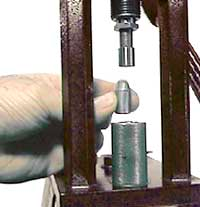
| Next, select -R, -S, or -H type dies/press. The -R means reloading press type dies, the -S means the S-press and -S type dies, and the -H means Hydro or Mega-Mite. Each die and press type will handle a given range of calibers. The -S type works with .102 to .458 diameter bullets. The -H type works with all calibers up to about 25mm. Reloading press swages are made in a more limited range of calibers styles. All die sets end with -R, -S, or -H, which describes the kind of press each set uses. Determine bullet length to further pin down die/press type. Bullets up to 1.3 inches can be made in the -S dies and press. Bullets longer than 1.3 inches will require the -H dies. Reloading press swage dies typically make shorter length bullets, with some exceptions for the lead semi-wadcutter paper-patch styles.
See Basic Packages | |||||||||
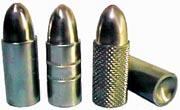 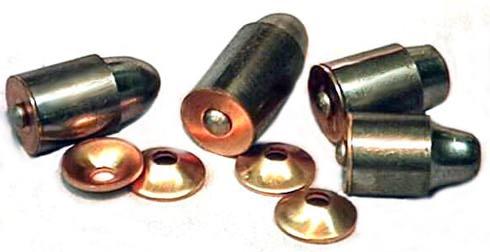 |
|
Jacketed bullets are designed around the jacket.
| |
   |
Click for Prices |
  |
Click for Prices |
  |
|
MATERIAL
|
Style and Design Bullet Design PageClick the above to select tools by looking at a list of bullet styles and clicking the nearest to what you want to make.
A two-die set first swages a lead core or cylinder, of a size that slips easily into a jacket. Then the second die pushes the lead down into the jacket and forms the nose, all at once. The nose must be entirely lead, and it must be long enough so that the end of the nose punch does not hit the end of the jacket (or else it would wrinkle and crush the jacket). Whether the nose itself is round, Keith, full wadcutter, a big hollow cavity, or some other special form like our Saber Tooth design, does not matter. That is just the selection of a different nose punch. Likewise, you can use this two-die set to make a lead, gas check, half jacket, 3/4-jacket or Base Guard bullet. (You cannot use it to bring the jacket past the full diameter and into the nose area.) This kind of bullet is typically a jacketed wadcutter or semi-wadcutter. We refer to the general style as a SWC because we have to call it something. The base can be flat, cupped, dished, hollow, or almost anything else so long as you take into consideration that it is formed by pressing against a punch, and the punch cannot have a cavity with zero thickness edge. Full Jacket Styles (Open Tip, Lead Tip, or Open Base styles) A full jacket set doesn't necessarily mean you have to make a FMJ bullet in it. Whenever you want to curve any part of the bullet, or bevel it smoothly without a step, you need the FJFB-3 3-die set. The first die, called a core swage, forms the lead core and extrudes away any surplus weight (gets rid of variations). The second die, called a core seater, seats the lead into the jacket (if you use a jacket). The third die is a semi-blind cavity die called the point former. The PF die has the curvature that you want formed in its cavity. At the tip is an ejection pin to push the bullet back out by the nose. If you push a lead slug into this die, it comes out looking just like the cavity: a lead bullet without a step or shoulder. You can skip the second die (CS or core seater) if you want smooth ogive lead bullets for handgun or rifle. If you want a jacketed bullet with a soft point, hollow point, or open tip, you would use the first two dies to prepare a cylindrical jacketed slug. Depending on the amount of lead you want exposed, or the amount of open tip area or kind of hollow cavity you want, you would use an appropriate shape and diameter of punch to just fit inside the jacket mouth and push the lead down, or to shape a conical cavity into the lead as you seat it. If you want to make a large lead tip, the punch used to seat the lead core into the jacket would be made to fit the CS die diameter, instead of fitting down into the jacket. Pushing the jacketed cylindrical slug into the point form die shapes the nose curve on the bullet. You can push it a little way in, and make a large tip, or push it all the way and close the tip to the maximum possible amount. The smallest tip opening is the size of the ejection pin in the die. Special techniques or a follow-up LT-1 lead tip die can help close this tip down all the way. To make purchasing easier, we package the two and three die sets in matching kits called the JSWC-2 and the FJFB-3. There is a -M, -S, or -H following the catalog number, which indicates the size and thread type of the die. -M is for the discontinued Silver Press or the S-Press, and has a 3/4-inch body die with 5/8-24 shank. The -S is for the S-Press and has a 1-inch body die with 5/8-24 shank. The -H dies fit the CSP-2 Mega Mite press or the large hydraulic presses, and have a 1.5-inch body with 1-20 threads. The punches for the -H dies are nearly as large as the rams on the S-Press. You cannot interchange dies in the presses except as indicated (-M fits the Series II, as does the -S). Lead Tips and Rebated Boattails All the other die sets, such as the LTFB-4 or RBTO-4 four and FRBO-5 or RBTL-5 five and FRBL-6 six die packages, just add either a lead tip forming die or a rebated boattail forming die/punch package to the 3-die set. The 3-die set is the basis for nearly any bullet you want to make that has a jacket or a smooth curved ogive or beveled base. Reloading Press Swaging Can you use a reloading press to swage bullets? The answer is yes, certain bullets. Even the toughest reloading presses are not designed so the die goes into the ram with self ejection on the down stroke. None of them have bearings or hardened tool steel rams. A Corbin press has a floating alignment system, like a CNC lathe, which puts the punch directly and positively into perfect alignment with the axis of the bullet, another feature missing on reloading presses. And finally, reloading presses do not let you drop the components easily into the die, since the loading press uses a die that fits the press head and is "upside down" for swaging. Combine all these factors with the 200% increased power and 500% increased strength of Corbin's presses, with their hardened and ground alloy steel rams, and you can see that a reloading press is not as good a choice for swaging as an actual press designed around the process, with dies that do not have to compromise their design to work around a reloading function. If you don't need fast production, or ability to continue adding features and making the more exotic designs, you can make bullets with soft lead (with or without jackets) using your sturdy RCBS-type slotted shellholder ram reloading press with 7/8-14 threaded press head. See the price list under "reloading press dies" for a complete listing of Pro-Swage and BSD-xxx-R dies. Any Corbin product ending with -R will work in a reloading press. For a complete package for making 224 or 243 rifle bullets using fired .22 LR cases, see the page 22 RF jacket making kit. |
To go into production, use hard lead, make calibers larger than .458 or longer than about 1.3 inches OAL, or do certain other somewhat exotic things that might take longer stroke or more pressure than the hand press dies can sustain, get one of the larger presses (CSP-2 or CHP-1) and a set of -H dies. Over 90% of the custom bullet making firms in the world (22 countries) use the CHP-1 press because it is so versatile and cost effective compared to any alternative system. -- Dave Corbin, |
Start writing here...

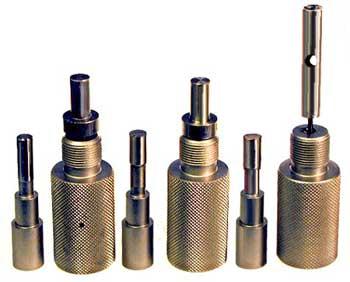
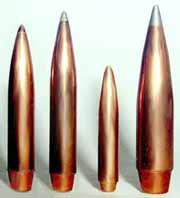
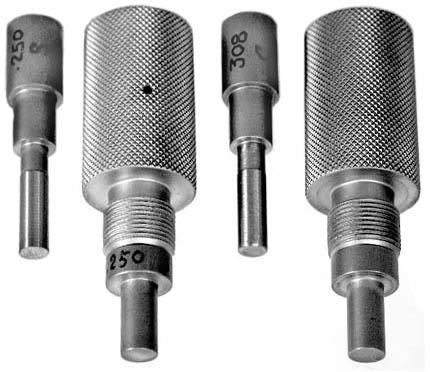

Learn What You Need To Swage Bullets